
Maggie Kayne, Bill Griffin and James Corcoran. Photo credit: Stefanie Keenan
Kayne Griffin Corcoran, a serene refuge off of a busy Los Angeles street, was originally conceived through a meeting of Maggie Kayne, Bill Griffin, and Jim Corcoran to discuss an artist commission and has since emerged as a destination in Los Angeles’ gallery network. Each offering a distinct perspective, the partners of Kayne Griffin Corcoran benefit from each other’s varied experiences, using their differences to foster innovation and constant evolution. A shared commitment to Los Angeles culture and history unites the three partners and acts as the framework from which they have built their roster of internationally-lauded artists and rigorous exhibition programming.
Bill Griffin has previously represented the likes of Southern California icons James Turrell and David Lynch and provides crucial insight on the strategic direction of the business. Jim Corcoran’s long career and extensive art historical knowledge helps to connect the thematic dots between established and contemporary artists. Maggie Kayne approached the art world first as a patron, turning her sights on galleries as a result of the potential of a partnership with Jim and Bill.
We spoke to Maggie and Bill about the partnership’s origins, the characted of Los Angeles, and the importance of developing a unique creative vision.
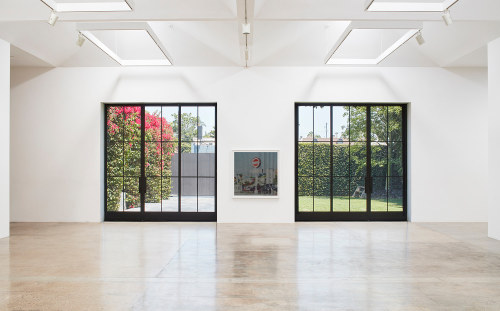
Installation view of Anthony Hernandez: Screened Pictures, 2019
When did you become interested in the art world?
Griffin: For me, I was always interested in a visual display of ideas and in learning about the ideas through looking at objects. The visual arts was something I gravitate towards as early as elementary school and continued through college. The first exhibition I attended was the King Tut show at the Metropolitan Museum of Art, circa 1978. My mother was a public-school teacher and she somehow got tickets to see the exhibition. I remember waiting in line with her a stepping into the first gallery, crossing that threshold into the Met, and for me, the world was changed that day.
Kayne: When I moved to New York for college I became friendly with a number of collectors who really opened up my eyes to new ways of seeing and engaging with the art world. I remember discovering this amazing ecosystem of artists, dealers, and collectors, and seeing opportunities to participate in and contribute to this network, not just be a passive observer. From that point on, I realized this was the world I wanted to be in. But it took me some time to find my home it. I interned at museums, worked at a couple of galleries, spent time with various dealers, and learned all the hard lessons pretty quickly.
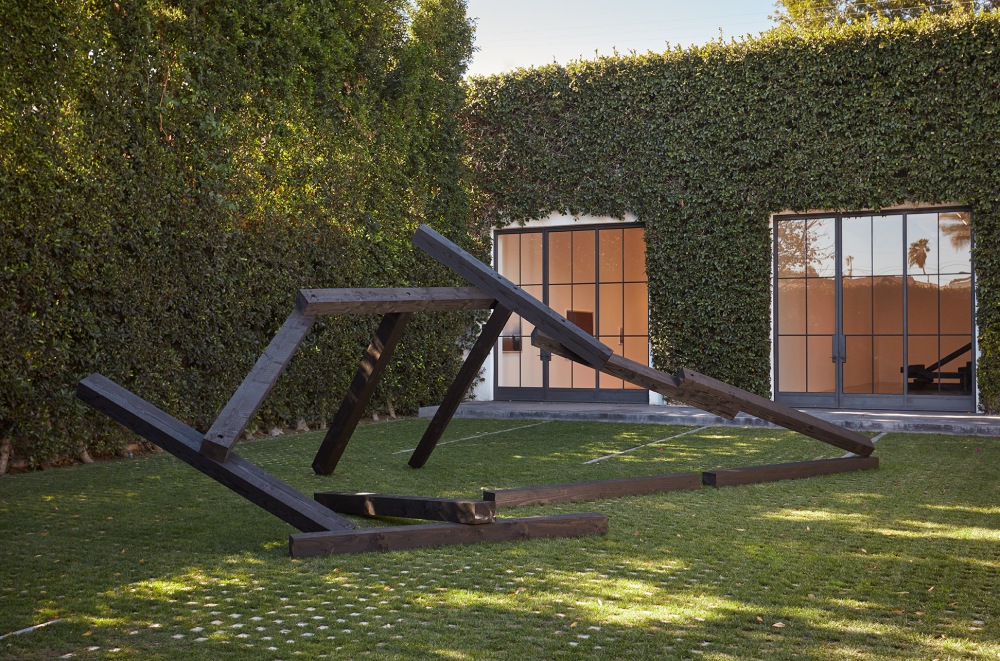
Installation view of Noboru Takayama, 2019
How did your careers as art dealers begin, and how does your history compare to where you stand now?
Griffin: In 1994, I borrowed a friend’s pick-up truck, drove to Home Depot, bought some drywall, and rented and old boat warehouse down in Costa Mesa. Twenty-five years later, here I am. I didn’t work for anybody and learned on my own. Working with Jim now for almost two decades has been a huge privilege and has been an incredible way to evolve my eye. Same with a younger partner like Maggie, who is to me incredibly inspiring and authentic in her relationship to art and the art object. I love to be exposed to new things, so every day since that Home Depot visit everything has continued to evolve with breakneck speed and has shaped my involvement in the art world.
Kayne: As mentioned earlier, I actually started off as a collector which was a really interesting departure point. The idea of opening a gallery didn’t occur to me until much later. In the beginning I just wanted to be around artists and absorb as much as I could. In addition to collecting, I would pick up odd projects here. The last thing I was doing before I met Bill was working with Hans Ulrich Obrist producing and filming interviews he conducted at the Venice Architecture Biennale in 2010. I also became very involved with several museums in a philanthropic capacity. I was a founding co-chair of the Hammer Museum’s Hammer Circle Group and a member of LACMA’s Director Circle. This dual identity as a patron/ collector on the one hand, and as a dealer on the other, has been complex to navigate at times but has also provided me with a really unique vantage point to understand the diverse needs of artists, collectors, institutions, and many of the other players in the larger ecosystem.
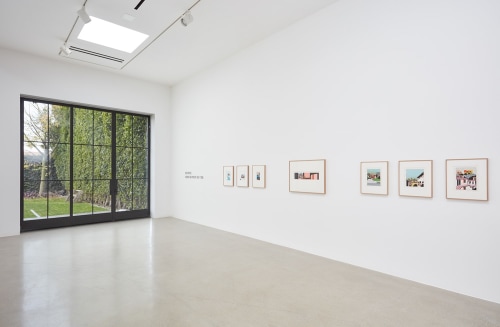
Installation view of Ken Price Works on Paper: 1967 - 1995, 2019
What initiated the partnership amongst the two of you and Jim Corcoran?
Kayne: At this point, I had segued into advising and was working with two clients who were considering a James Turrell Skyspace. This led me to Bill and Jim who represented James here in L.A. I met with them and ended up having a three-hour conversation with Bill. Bill was doing really innovative things with his gallery, both operationally and programmatically, and I was really inspired by the meeting. He then called me two hours later and said “I want to offer you a job and this is what I think you can bring to the table, and this is what I think I can bring to you.” I started working for Bill in January of 2011 and by June we began to explore a more formal partnership. While working with Bill, I also got to know Jim quite well and knew his experience and reputation would be incredibly additive to the partnership. Bill said there was no way that Jim would be on board, but we called him in to propose the idea and he said “Sure.” It was totally unplanned and, like anything, was also a function of good timing. Sometimes I laugh because it’s a bit of an odd match but the truth is the three of us have a great rapport, really complementary skill sets, and it just works! Do each of you play specific roles at the gallery?
Griffin: The three of us just naturally respected each other and, like Maggie said, brought different things to the pot. As there is a generational difference of two decades that separate each of us, we have different perspectives on the culture that we live in and recognized this was strategically interesting. We believed in each other’s contributions and visions and just started working together. It has evolved into different things since then, Maggie is in a day-to-day capacity and is very interested in the creative studios and what’s happening out in the world. She’s very active in pursuing those ideas, working in collaborative developments with studios, curators, and other gallerists. I continue to work with a few specific studios, I handle some key client relationships and work on strategically evolving the vision. Jim, as Maggie said, brings his deep network of relationships, and pioneering knowledge of the Southern California art scene.
Kayne: I think if you were to divide it up, my role is definitely more creative. Bill is incredibly strategic and organized. He also appreciates the creative, but he is providing the structure that enables all of us to be successful and to implement our ideas in an effective way. Jim comes in with some crazy and brilliant ideas but also bring deep art historical and institutional knowledge to the table.
Griffin: It’s very unique and rare to find three people that genuinely, as Maggie said, are kind of odd and outliers, in different ways, but still come together with a vision and have the ability to execute it.
Kayne: I think we’re also very aligned in our programmatic decisions in that we only work with artists we really believe in, even if the financial upside isn’t immediately apparent. We’re playing the long game and recognize that the market may take a little longer sometimes to verify an artist. We also really enjoy the cross-generational conversation that naturally occurs as a result of the twenty years between each of us.
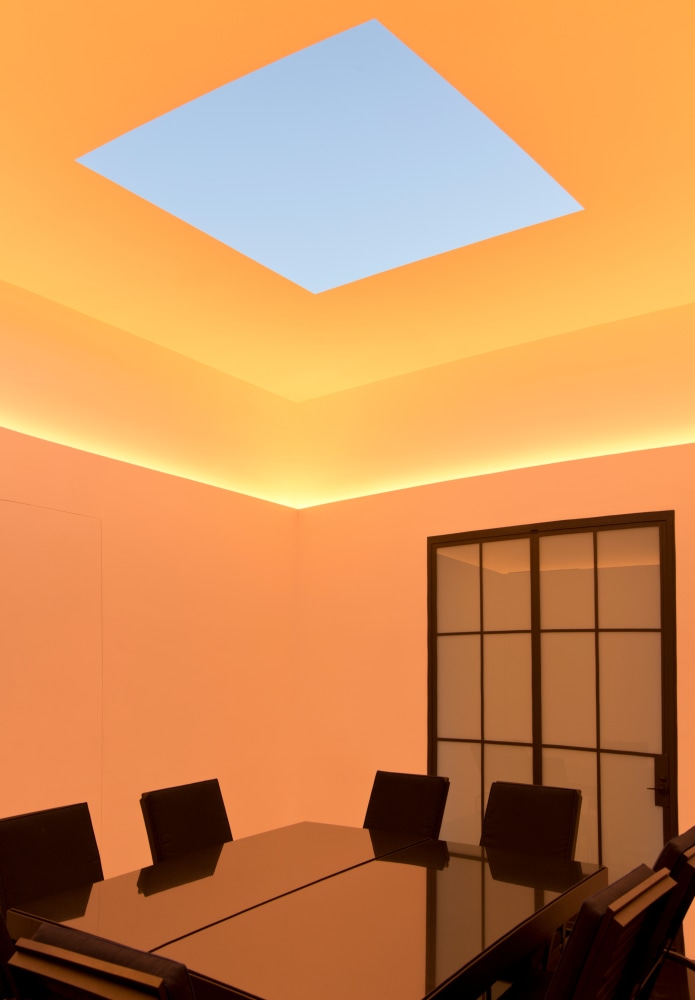
James Turrell, La Brea Sky, 2013
Is there a current through Kayne Griffin Corcoran that unites your three different perspectives?
Griffin: Jim came to Kayne Griffin Corcoran having worked with the studios of legendary artists including Ken Price, John McCracken, and Ed Ruscha, and his focus on the Southern California School is something that is still central to the gallery’s DNA.
Kayne: James Turrell is in many ways the cornerstone of the gallery. The three of us met through a Turrell commission and one of the first shows we did when we opened the gallery was an exhibition of Turrell’s project at the Roden Crater, called Sooner Than Later, Roden Crater. Through our experience selling James’ work, we realized when we got in this space that it would be a lot easier for us to sell holes in ceilings if we had one in our own! To have this Skyspace as the physical and spiritual center of the gallery is incredibly special and was also a game-changer for the business.
Griffin: We had long discussions with him about how to put a Skyspace into the working gallery and it came down to the fact that Skyspaces are places for people to meet and communicate, and that is what a conference room does in a business. Creating this Skyspace inspired James to look at the entire gallery space and address all aspects and we gave him free range to do that. The gallery is located on La Brea Avenue, this cement and tar highway packed with tens of thousands of cards every day racing by and then there’s our gallery, this kind of green oasis. That’s all James.
Kayne: He designed every detail and even mapped out the flow of the space. We brought him in even before the architect, because we knew that he had the ability, more than anyone else, to create a really thoughtful and considered experience. In fact, it was his idea to put a Skyspace in the conference room. He was most excited about creating a gallery space for his peers that had what he refers to as perfect flexible light. He says that he has shown in hundreds of space throughout the world and very rarely, if ever, doe she see an exhibition space with perfect light.
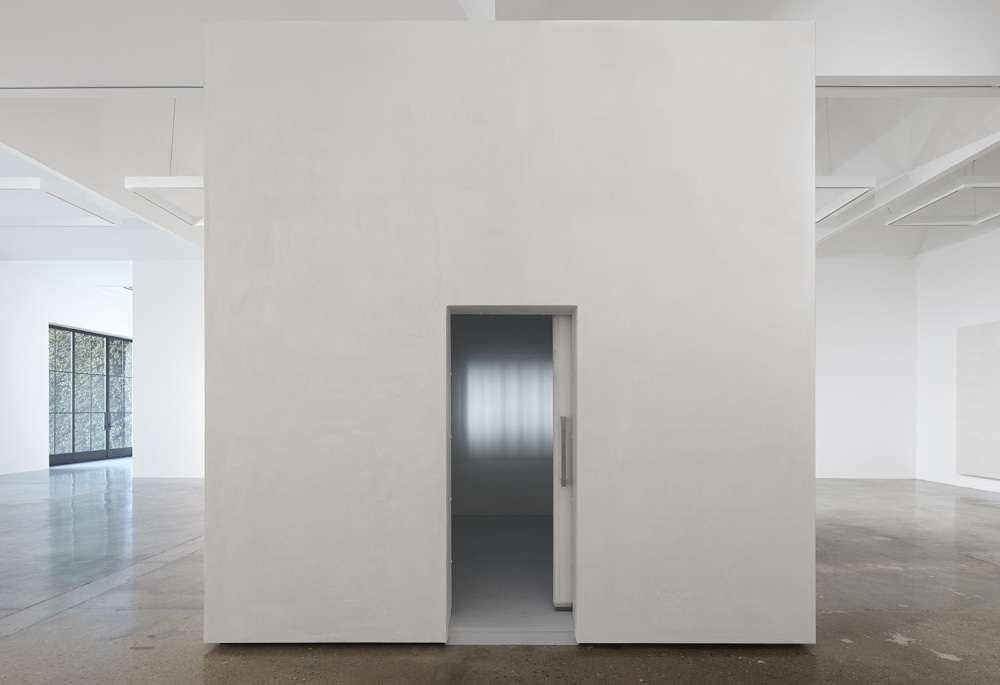
Installation view of Mary Corse: Then and Now, 2017
How do you see the gallery in the larger landscape of the Los Angeles art scene?
Kayne: The vibe of our gallery, both in terms of the programming and the physical space is very much tied to the DNA of Los Angeles. We love this city and are really invested in the cultural community here. This is reflected in the artists we work with, the institutional relationships we cultivate, but also the gallery itself, and even the way the architecture was designed to embrace the particular geographical and cultural differences that makes Los Angeles so unique. We’ve got this incredible light, the weather is unbelievable, and being outside is a huge part of the culture here. We’ve really capitalized on this with our courtyard, which we use all the time for outdoor programming and entertaining. I think we’ve also managed to create a really special and refreshing work culture at the gallery which has allowed us to attract and build an incredibly talented group of professionals.
Griffin: I think our philosophy has developed through our time in L.A. and collaboration is critical to our gallery’s character. We believe in finding good partners globally outside the gallery and fostering productive, long term relationships. I think it helps many galleries know that we are singularly focused and grounded in Los Angeles. Our future is like the past, very organic and open. We know who we are and we look out towards the world but we are very satisfied with the City of Angeles. That’s our history. It’s been Maggie’s growing up all her life, mine for the last two decades, Jim’s for his life. That threads through everything that we do and through all of our actions.
As a newer member to the ADAA, what made you want to join the Association?
Griffin: I think that the ADAA is important as a historical network, but also in the fact that we can all contribute and help it evolve. It makes us better, too. The ADAA’S services affect many elements of our business. I find it to be a wonderful organization to be a part of, and I mean that genuinely.
What significant changes have you seen to the gallery business over the past decade or so?
Griffin: My thought right off the bat is the speed of communication and the speed of how things take place. When I started, we had FedEx and fax machines, and all those things were fast relative to the generation before that. Today, the quickness, the ability to connect and communicate with peers globally, instantaneously and with incredible resources, is remarkable.
Do you have any advice for an aspiring art dealer?
Griffin: Speaking form a dealer’s standpoint, my advice would be don’t follow the market. Create a unique vision, support your artists, work hard, and success will follow.
Do you have any advice for a budding collector?
Kayne: The eye is a muscle and needs to be exercise – and not just online! Show up at gallery openings, visit museums, attend art fairs, and make an effort to see things in person. And buy with your eyes and your gut, not with your ears.